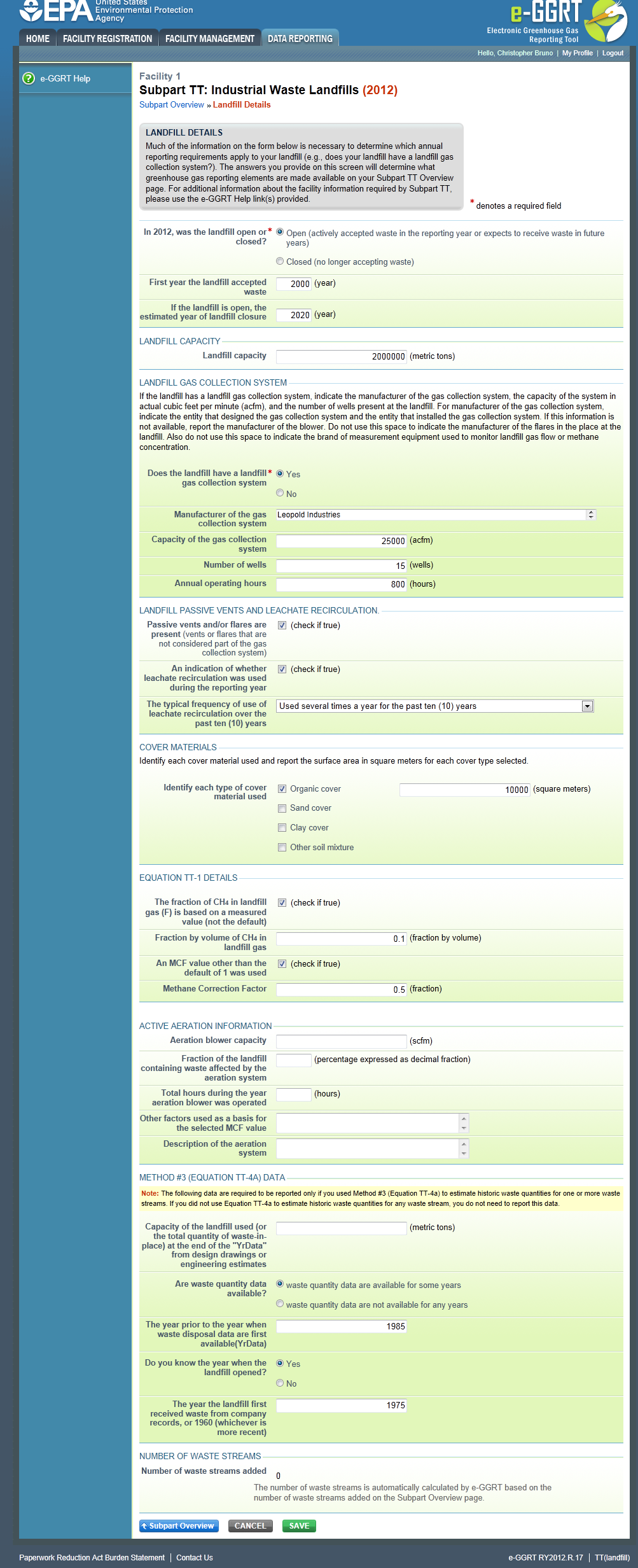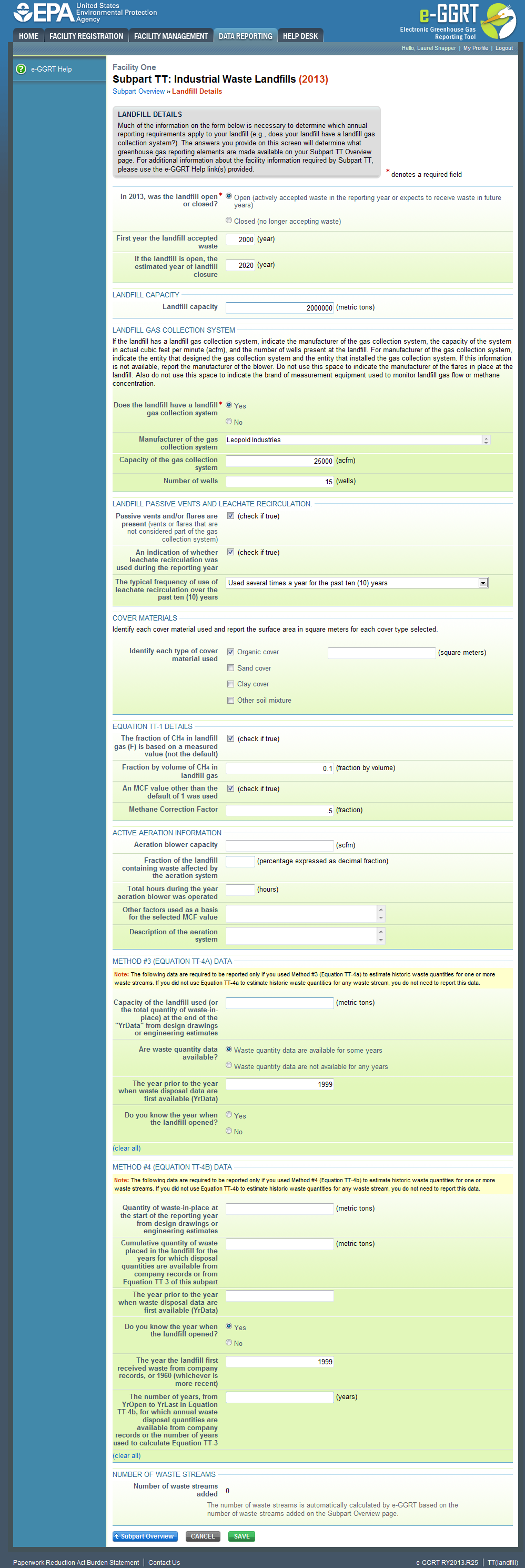This page provides a step-by-step description of how to enter summary information on industrial waste landfills as required by Subpart TT of the Greenhouse Gas Reporting Program.
| Excerpt |
|---|
Much of the information on the form |
...
is necessary to determine which annual reporting requirements apply to your landfill (e.g., |
...
if you indicate that your landfill |
...
has a landfill gas collection system |
...
, additional questions will appear). The answers you provide |
...
will determine what |
...
greenhouse gas reporting elements are made available on your Subpart TT Overview page. |
Adding or Updating Landfill Details for this Facility
| Wiki Markup |
|---|
| Composition Setup |
|
Wiki Markup
| Toggle Cloak |
|---|
|
|
| Cloak | |||||||
|---|---|---|---|---|---|---|---|
| Wiki Markup | |||||||
| type=none|
| zone=true}
| ||
| Wiki Markup | ||
|---|---|---|
| {cloak} |
To add or modify Subpart TT summary information for this industrial waste landfill, press the OPEN button located opposite “Landfill Details.”
Landfill Details must be populated before other information about the landfill and its , the waste streams disposed there, and methane generation or emissions can be entered.
| Wiki Markup |
|---|
{composition-setup}{composition-setup} |
Wiki Markup
| Toggle Cloak |
|---|
|
|
| Cloak | |||||||
|---|---|---|---|---|---|---|---|
| Wiki Markup | |||||||
| type=none|
| zone=true}
| Wiki Markup |
|---|
{cloak} |
| ||
| |
The following industrial waste landfill information is collected for Subpart TT:
- Indicate if the landfill was open or closed in 2012the current reporting year. A landfill is considered open if it is actively receiving waste in the reporting year or expects to receive waste in future years. A landfill that closed during the reporting year, but also received waste during the reporting year is considered open for the particular reporting year. A landfill is considered closed if it did not receive waste in the reporting year and does not expect to receive waste in any future years.
- If the landfill was open in 2012the reporting year, indicate the year in which the landfill first started accepting waste for disposal.
- If the landfill was open in 2012, indicate Indicate the year in which the landfill is expected to close.
- If the landfill was closed prior to and not during the reporting year:
- Indicate 2012, indicate the last year that the landfill accepted waste and the capacity of that landfill.
- The capacity of the landfill in metric tons.
...
A landfill gas collection system means is defined as a system of pipes used to collect landfill gas from different locations in the landfill by means of a fan or similar mechanical draft equipment to a single location for treatment or use. A single landfill may have multiple gas collection systems. Landfill gas collection systems do not include “passive” systems, whereby landfill gas flows naturally to the surface of the landfill where an opening or pipe (vent) is installed to allow for natural gas flow.
...
- The manufacturer of the gas collection system.
- The capacity of the system in actual cubic feet per minute (acfm).
- The number of wells present at the landfill.The annual operating hours for the gas collection system (fREC in equations HH-7 and HH-8) per 98.346(i)(7).
For manufacturer of the gas collection system, indicate the entity that designed the gas collection system and the entity that installed the gas collection system. If this information is not available, report the manufacturer of the blower. Do not use this space to indicate the manufacturer of the flares in the place at the landfill. Also, do not use this space to indicate the brand of measurement equipment used to monitor landfill gas flow or methane concentration.
...
- Identify each type of cover material in use at the landfill. For each cover material used, identify the surface area (in square meters) of the landfill sections that contain waste and that are associated with the selected cover type. Choose from the following cover types (more than one type of cover may be selected) and enter the surface area into the box that pops up next to it:
- Organic
- Clay
- Sand
- Other soil mixture (this should be selected for any cover type other than organic, clay, or sand)
Equation TT-1 Details
| Toggle Cloak | ||
|---|---|---|
|
| Cloak | ||||||
|---|---|---|---|---|---|---|
| ||||||
| |
Subpart TT also requires you to indicate the following:
- If the fraction of CH4 in the landfill gas (F) as used in Equation TT-1 was based on measured values, check the box and enter the measured value (dry basis and corrected to 0% oxygen) as a percentage expressed as a decimal fraction. If no measured value was used, do NOT check the box, and a default value of 0.5 will be used in the calculation run by e-GGRT.
- If the facility used a measured value for the MCF MCF other than the default value of 1.0 in Equation TT-1 of this subpart, check the box and enter the MCF used as a decimal fraction. If the MCF default value was used, do NOT check the box and the default value will be entered as 1.0. If you check the box that you did not use the default value for MCF, that means that you must have active aeration at your landfill. Enter the following information about the aeration system in place at the landfill:
- The aeration blower capacity (in scfm)
- The fraction of the landfill containing waste affected by aeration (enter the percentage expressed as a decimal fraction)
- The total number of hours during the year in which the aeration blower was operated
- Other factors that were used as a basis for the MCF value that was used.
- Any additional description of the aeration system (e.g., the number of blowers).
...
- If the landfill is open, enter the capacity of the landfill in metric tons used (or the total quantity of waste-in-place) at the end of the "YrData" from design drawings or engineering estimates.
- An indication as to whether waste quantity information data are available for some years or not available for any years. Note that this is not a specific data reporting requirement in citation 98.466, but is needed in order for e-GGRT to properly collect the following:
- When landfills have waste quantity data available for some years, enter the year prior to the year when waste disposal data are first available for all subsequent years from company records.
- When landfills do not have waste quantity data for any years, enter the year in which the landfill last received waste.
- An indication as whether the facility knows when the landfill was opened.
Method 4 (Equation TT-4b) Data
The questions in this section should only be answered if Equation TT-4b was used to calculate waste quantities for one or more waste streams in years prior to the reporting year.
Please note the yellow box: “The following data are required to be reported only if you used Method #4 (Equation TT-4b) to estimate historic waste quantities for one or more waste streams. If you did not use Equation TT-4b to estimate historic waste quantities for any waste stream, you do not need to report this data."
If Equation TT-4b was used, enter the following information:
- If the landfill is open (as indicated at the top of the Landfill Details page), enter the quantity of waste-in-place in metric tons at the start of the reporting year from design drawings or engineering estimates.
- If the landfill is closed (as indicated at the top of the Landfill Detail page), indicate if the waste-in-place quantity is know (yes or no)
- If the waste-in-place quantity is known, enter the quantity of waste-in-place at the start of the reporting year
- If the waste-in-place quantity is known, enter the landfill design capacity. The design capacity is the maximum amount of solid waste a landfill can accept. See section 98.468 for the complete definition of this term
- Enter the cumulative quantity of waste placed in the landfill for the years for which disposal quantities are available from company records or from Equation TT-3 of this subpart.
- Enter the year prior to the year when waste disposal data are first available.
- Indication whether the facility knows when the landfill was opened. One of the following two scenarios will result depending on your answer:
- If you know when the facility was opened, either enter the year 1960 or the year in which the landfill first received waste from company records, whichever is more recent.
- If you do not know the year in which the landfill first received waste from company records, the year 1960 will be pre-populated by e-GGRT.
- The number of years for which annual waste disposal quantities are available from company records or the number of years used to calculate Equation TT-3.
A value for the Number of Waste Streams added is automatically populated by e-GGRT based on how many waste streams are reported at the landfill. If no waste streams have yet been reported, this number will be zero. Information on how to add waste streams, as required by the system, may be found at Subpart TT Waste Stream Summary Information.
When you have entered the required information, click SAVE. You will be brought back to the top of the Landfill Details page at which time you may check over the information you entered. When you have completed your check, click SUBPART OVERVIEW to return to the Subpart Overview page.
...
...






